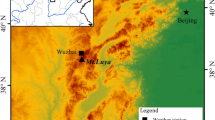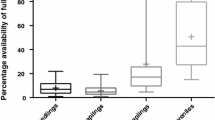Abstract
Postharvest needle abscission in balsam fir varies considerably depending on the season and may be dependent on endogenous hormones of roots or shoots. Samples were obtained from three trees each month from April 2013 to November 2013 and evaluated for retention. In addition, root and needle tissues were analyzed for abscisic acid, cytokinins, auxins, and gibberellins and their conjugates. There was a 3.5-fold increase in time until needle abscission commencement and 1.75-fold increase in time until complete abscission in autumn compared to spring. There were several changes to root and needle hormones with respect to harvest time, but fewer hormones were linked to postharvest needle retention. Among all hormones analyzed, both isopentenyladenine and isopentenyladenosine in roots were strongly linked to needle retention. When isopentenyladenine was present in roots, needle abscission took 114% longer to begin and 58% longer to finish. Isopentenyladenosine in roots was the strongest hormonal predictor of needle retention (R 2 = 79%). Dihydrozeatin riboside (R 2 = 37%), trans-abscisic acid (R 2 = 50%), and isopentenyladenosine (R 2 = 59%) in the needles were also strong predictors of needle retention. The relative effectiveness of certain hormones in predicting needle retention and speculation pertaining to the roles these hormones could play are discussed.




Similar content being viewed by others
Abbreviations
- 2iP:
-
Isopentenyl adenine
- 7′-OH-ABA:
-
7′-Hydroxy ABA
- ABA:
-
Abscisic acid
- ABAGE:
-
Abscisic acid glucose ester
- dhZ:
-
Dihydrozeatin
- dhZR:
-
Dihydrozeatin riboside
- DPA:
-
Dihydrophaseic acid
- HPLC:
-
High-pressure liquid chromatography
- HPLC-ESI-MS/MS:
-
HPLC-electrospray ionization tandem mass spectrometry
- iPA:
-
Isopentenyl adenosine
- GA:
-
Gibberellins
- IAA:
-
Indole acetic acid
- IAA-Ala:
-
IAA-alanine
- IAA-Asp:
-
IAA-asparagine
- IAA-Glu:
-
IAA-glucoside
- IAA-Leu:
-
IAA-leucine
- NAC:
-
Needle abscission commencement
- NRD:
-
Needle retention duration
- PA:
-
Phaseic acid
- Z:
-
Zeatin
- ZOG:
-
Zeatin-O-glucoside
- ZR:
-
Zeatin riboside.
References
Abrams SR, Nelson K, Ambrose SJ (2003) Deuterated abscisic acid analogs for mass spectrometry and metabolism studies. J Label Compd Radiopharm 46:273–283
Boussiba S, Rikin A, Richmond AE (1975) The role of abscisic acid cross-adaptation in tobacco plants. Plant Physiol 56:337–339
Chastagner G, Riley K (2007) Solving the needle loss nuisance – Christmas tree research examines the effect of harvest date on true fir needle retention. Great Lakes Christmas Tree J 2:36–39
Chiwocha SDS, Abrams SR, Ambrose SJ, Cutler AJ, Loewen M, Ross ARS, Kermode AR (2003) A method for profiling classes of plant hormones and their metabolites using liquid chromatography electrospray ionization tandem mass spectrometry: an analysis of hormone regulation of thermodormancy of lettuce (Lactuca sativa L.) seeds. Plant J 35:405–417
Chiwocha SDS, Cutler AJ, Abrams SR, Ambrose SJ, Yang J, Ross ARS, Kermode AR (2005) The etr1 2 mutation in Arabidopsis thaliana affects the abscisic acid, auxin, cytokinin and gibberellin metabolic pathways during maintenance of seed dormancy, moist chilling and germination. Plant J 42:35–48
Cornish K, Zeevaart JAD (1985) Abscisic acid accumulation by roots of Xanthium strumarium L. and Lycopersicon esculentum Mill. In relation to water stress. Plant Physiol 79:653–658
Eriksson ME (2000) The role of phytochrome A and gibberellins in growth under long and short day dehydration studies in hybrid aspen. PhD thesis, Swedish University of Agriculture, Umea, Sweden
Garrison FR, Brinker AM, Nooden LD (1984) Relative activities of xylem-supplied cytokinins in retarding soybean leaf senescence and sustaining pod development. Plant Cell Physiol 25:213–224
Havlova M, Dobrev PI, Motyka V, Storchova H, Libus J, Dobra J, Malbeck J, Gaudinova H, Vankova R (2008) The role of cytokinins in response to water deficit in tobacco plants overexpress trans-zeatin O-glucosyltransferase gene under 35 S or SAG 12 promoters. Plant Cell Environ 31:341–353
He P, Jin JY (1999) Relationships among hormone changes, trans-membrane flux of Ca2+ and lipid peroxidation during leaf senescence in spring maize. Acta Bot Sin 41:1221–1225
Hoque E (1982) Biochemical aspects of stress physiology of plants and some considerations of defense mechanisms in conifers. Eur J For Path 12:280–296
Lada RR, MacDonald MT (2015) Understanding the physiology of postharvest needle abscission in balsam fir. Front Plant Sci 6:1069
MacDonald MT, Lada RR (2013) Biophysical and hormonal changes linked to postharvest needle abscission in balsam fir. J Plant Growth Regul 33:602–611
MacDonald MT, Lada RR, Martynenko AI, Dorais M, Pepin S, Desjardins Y (2010) Ethylene triggers needle abscission in root-detached balsam fir. Trees 24:879–886
MacDonald MT, Lada RR, Veitch RS, Thiagarajan A, Adams AD (2014) Postharvest needle abscission resistance of balsam fir (Abies balsamea) is modified by harvest date. Can J For Res 44:1394–1401
MacDonald MT, Lada RR, Veitch RS (2016) Seasonal changes in balsam fir needle abscission patterns and links to environmental factors. Scand J For Res. DOI:10.1080/02827581.2016.1235726
Milborrow BV (2001) The pathway of biosynthesis of abscisic acid in vascular plants: a review of the present state of knowledge of ABA synthesis. J Exp Bot 52:1145–1164
Mitcham-Butler EJ, Hinesley LE, Pharr DM (1988) Effects of harvest date, storage temperature, and moisture status on postharvest needle retention of Fraser fir. J Environ Hortic 6:1–4
Munns R, Sharp RE (1993) Involvement of abscisic acid in controlling plant growth in soils of low water potential. Aus. J Plant Physiol 20:425–437
Nooden LD, Guiamet JJ, John I (1997) Senescence mechanism. Physiol Plant 101:746–753
Ohkuma K, Lyon JL, Addicot FT, Smith OE (1963) Abscisin II, an abscission-accelerating substance from young cotton fruit. Science 142:1592–1593
Osborne DJ, Morgan PW (1989) Abscission. Crit Rev Plant Sci 8:102–129
Patterson SE, Bolivar-Medina JL, Falbel TG, Hedtcke JL, Nevarez-McBride D, Maule AF, Zalapa JE (2015) Are we on the right track: can our understanding of abscission in model systems promote or derail making improvements in less studies crops? Front Plant Sci 6:1268. doi:10.3389/fpls.2015.01268
Ross ARS, Ambrose SJ, Cutler AJ, Feurtado AJ, Kermode AR, Nelson K, Zhou R, Abrams SR (2004) Determination of endogenous and supplied deuterated abscisic acid in plant tissues by high-performance liquid chromatography-electrospray ionization tandem mass spectrophotometry with multiple reaction monitoring. Anal Biochem 329:324–333
Sakakibara H (2004) Cytokinin biosynthesis and metabolism. In: Davies PJ (ed) Plant hormones: biosynthesis, signal transduction, action! Springer, New York, pp 95–114
Schwartz SH, Zeevaart JAD (2004) Abscisic acid biosynthesis and metabolism. In: Davies PJ (ed) Plant hormones: biosynthesis, signal transduction, action! Springer, New York, pp 137–155
Sexton JA, Roberts (1982) Cell biology of abscission. Ann Rev Plant Physiol 33:133–162
Taylor JE, Whitelaw CA (2001) Signals in abscission. New Phytol 151:323–430
Thiagarajan A, Lada R, Pepin S, Forney C, Desjardins Y, Dorais M (2012) Characterization of phytohormonal and postharvest senescence responses of balsam fir (Abies balsamea (L.) Mill.) exposed to short-term low temperature. Trees 26:1545–1553
Thiagarajan A, MacDonald MT, Lada RR (2016) Environmental and hormonal physiology of postharvest needle abscission in Christmas trees. Crit Rev Plant Sci. doi:10.1080/07352689.2015.1133965
Van Staden J, Cook E, Nooden LD (1988) Cytokinins and senescence. In: Nooden LD, Leopold A (eds) Senescence and aging in plants. Academic Press, London, pp 281–328
Watanabe M, Bessho H, Suzuki A, Komori S (2008) Seasonal changes of IAA and cytokinin in shoots of columnar type apple trees. Acta Hortic 774:75–80
Zaharia LI, Walker-Simmon MK, Rodriguez CN, Abrams SR (2005) Chemistry of abscisic acid, abscisic acid catabolites and analogs. J Plant Growth Regul 24:274–284
Acknowledgements
This work was funded by the Natural Science and Engineering Research Council (CRDPJ-364061-07/09) and the Atlantic Canada Opportunities Agency (195310). The authors greatly appreciate contributions made by the Christmas Tree Council of Nova Scotia and Nova Scotia Department of Natural Resources. Finally, the authors thank Matthew Priest for unrestricted access to the balsam fir orchard.
Author information
Authors and Affiliations
Corresponding author
Rights and permissions
About this article
Cite this article
MacDonald, M.T., Lada, R.R. Changes in Endogenous Hormone Levels Explains Seasonal Variation in Balsam Fir Needle Abscission Patterns. J Plant Growth Regul 36, 723–733 (2017). https://doi.org/10.1007/s00344-017-9676-8
Received:
Accepted:
Published:
Issue Date:
DOI: https://doi.org/10.1007/s00344-017-9676-8




